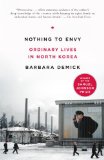Summary | Excerpt | Reviews | Beyond the Book | Read-Alikes | Genres & Themes | Author Bio

Critics' Opinion:
Readers' Opinion:
First Published:
Dec 2009, 336 pages
Paperback:
Sep 2010, 336 pages
 Book Reviewed by:
Book Reviewed by:
Stacey Brownlie
Buy This Book
This article relates to Nothing to Envy
Korea's earliest known history begins around the 4th century B.C. Korea developed into several regions based around walled communities that acted somewhat like states. China controlled some southern parts of Korea, but in the 7th century A.D., one of the states, Silla, was able to drive China out of Korea's borders. As a result, Korea was a single kingdom ruled from within by succeeding dynasties until the conclusion of the Russo-Japanese War (1904-05).
In 1905, Japan began to occupy Korea and later claimed the country as part of its own. Japan's occupation of Korea caused the formation of many political and resistance groups, including the Korean Communist Party. Some Koreans also helped the Manchu region of China to fight against Japan's advances in the early 1930's. After Japan's defeat in World War II, Korea's fate came under the control of the Allied countries. Soviet forces occupied the north and United States forces occupied the south.

In 1948, new governments were established, the nominally democratic South Korea and Communist North Korea divided at the 38th parallel - an arbitrary geographic marker. Kim Il-sung and his Democratic People's Republic of Korea (DPRK) were supported by the Soviet Union, while the United States backed South Korea, known as the Republic of Korea (ROK). Kim Il-sung, who had been a resistance fighter against the Japanese, rose to power in the North as the head of the communist Korean Worker's Party.
Both North and South Korea considered themselves to be the true Korea. In 1950, Kim Il-sung invaded South Korea and attempted to make it part of the DPRK. The United States intervened on behalf of South Korea; the Korean War (or the 'Fatherland Liberation War' in North Korea) lasted until an armistice agreement in 1953. The geographic division between the two Koreas remained basically the same following these years of fighting, but North Korea became increasingly more isolated, with the Demilitarized Zone (DMZ) running as a 2-3 mile wide buffer between the two. It is now the most heavily militarized border in the world.
Kim Il-sung's son Kim Jong-il was announced as successor in 1980. After Kim Il-sung died in 1994, his son grew to be the active ruler. North Korea's economy has severely declined in the past few decades. Supplies from humanitarian organizations and international aid have been required to provide relief from food shortages and lack of basic necessities. North Korea has made some economic changes in the early 21st century such as increased interaction with South Korea and the abolishment of the food rationing system.
In September 2010, Kim Jong Un, believed to be the son of Kim Jong-il's third wife, became second in command of the ruling Workers' Party's powerful Central Military Commission just a day after his father, who is believed to be quite sick, made him a four-star general. Very little is known about Kim Jong Un, who is clearly now positioned as the Party's future leader. He is thought to be between 26 and 28, and to have been educated briefly in Switzerland.
Filed under Places, Cultures & Identities
![]() This "beyond the book article" relates to Nothing to Envy. It originally ran in January 2010 and has been updated for the
September 2010 paperback edition.
Go to magazine.
This "beyond the book article" relates to Nothing to Envy. It originally ran in January 2010 and has been updated for the
September 2010 paperback edition.
Go to magazine.





The House on Biscayne Bay
by Chanel Cleeton
As death stalks a gothic mansion in Miami, the lives of two women intertwine as the past and present collide.

The Flower Sisters
by Michelle Collins Anderson
From the new Fannie Flagg of the Ozarks, a richly-woven story of family, forgiveness, and reinvention.

The Funeral Cryer by Wenyan Lu
Debut novelist Wenyan Lu brings us this witty yet profound story about one woman's midlife reawakening in contemporary rural China.
Your guide toexceptional books
BookBrowse seeks out and recommends the best in contemporary fiction and nonfiction—books that not only engage and entertain but also deepen our understanding of ourselves and the world around us.